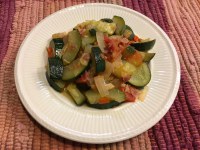Prairie Fare: Onions Offer Layers of Goodness
(Click an image below to view a high-resolution image that can be downloaded)
By Julie Garden-Robinson, Food and Nutrition Specialist
NDSU Extension Service
As I examined the maturing produce in our garden, I decided not to harvest any onions. Although the stems were sturdy and green, the onion bulbs were fairly small.
Young onions are tasty, but I gave them the opportunity to grow.
Whenever I look at onions growing in our garden, I remember “the year of the onions” when I was a kid. My parents must have gotten a good deal on onion sets that year. More likely, the weather conditions were just right for a bumper crop.
Our white onions grew to the size of baseballs. We filled the back of a pickup truck full of onions. As I helped load onions, I was a little worried that we would have them for every meal that winter. Fortunately, every visitor left our home with a bag of onions. Our guests didn’t seem to mind.
Onions are a popular vegetable. Food historians estimate that humans have eaten them for more than 5,000 years. For example, onions have been found in tombs of the ancient Egyptians.
Through the years, onions have been used for medicinal purposes and even as wedding gifts in early history. I have not seen onions on a wedding gift registry these days.
Onions can be eaten raw or cooked, and they are available in a wide range of sizes and colors, including red, yellow and white. Green onions, or scallions, also add flavor to foods.
According to the National Onion Association, our yearly consumption increased from 12.2 pounds per person in 1982 to 20 pounds in 2010 in the U.S. Worldwide, people munch their way through more than 13.5 pounds annually.
While Idaho, Oregon, Washington and California are the leading onion-producing states, North Dakota and Minnesota are in the top 15 onion-producing states, according to 2016 data. In North Dakota, onions, along with several other vegetables and fruits, are considered specialty crops.
One medium onion has about 60 calories, 11 grams (g) of carbohydrate, 1.6 g of protein and 3 g of fiber. Onions are good sources of vitamin C and provide minerals, including magnesium, phosphorous and potassium.
This unique profile of vitamins and minerals, along with their natural phytochemicals (plant chemicals), confer some disease-fighting properties to the humble onion. Regular consumption of onions is good for our heart, may fight cancer and also may help build our bones, according to some recent research.
Be sure to select onions that are firm and free of cuts and soft spots. Soft spots on the onion usually indicate underlying spoilage. The skin should be dry and paperlike.
Avoid storing onions in plastic bags. Store onions in a mesh bag or other container with some holes in a cool, dark, dry place. Be sure to refrigerate peeled or cut onions and use within a week to 10 days.
Cutting onions can be a real tear-jerker, so to avoid dramatic cooking experiences in your kitchen, try these tips:
- Chill the onion for 30 minutes to one hour before chopping to slow the release of sulfur gas.
- Chop them from the top end instead of the root end.
- Use a sharp knife so you can chop faster.
- Cut onions under cold, running water to reduce eye irritation.
- Try applying some lemon juice to remove the scent of onions from your hands.
Some people shy away from onions because they may leave you with bad breath. The natural sulfur compounds that provide their flavor also are responsible for some of their health benefits, including some cancer-fighting properties.
If you worry about halitosis after eating onions, remember that parsley is an excellent breath freshener. So eat the “garnish.” Or serve everyone the same meal and you all will have halitosis together.
Be inventive in your kitchen with onions and all the delicious produce of summertime. Add onions to kebobs and grill, caramelize them to make onion soup or try making baked onion rings. See https://www.ag.ndsu.edu/fieldtofork for more information about growing, preserving and preparing locally grown produce.
After harvesting some items from our garden, I put together a quick side dish without the benefit of a recipe. The “surprise” is the addition of a little crumbled bacon and some cayenne pepper. To save time, I picked up some crumbled bacon from a grocery store salad bar.
Garden Veggie Surprise
2 strips bacon, fried, drained and crumbled
2 tsp. canola oil or your favorite cooking oil
1/2 c. onion, diced
1 small hot pepper, diced finely
2 c. zucchini, diced
1 medium tomato, diced
1/4 tsp. seasoning salt
1/8 tsp. cayenne pepper
Cook bacon, drain and crumble (or use commercial crumbled bacon). Heat the olive oil in a pan. Add onion, pepper and bacon. Stir until onion is translucent (about three to five minutes). Add zucchini, tomato and seasonings, then stir. Cover and heat for about 10 minutes over medium-low heat. Serve.
Makes four servings. Each serving has 70 calories, 4.5 g fat, 3 g protein, 5 g carbohydrate, 1 g fiber and 180 milligrams sodium.
(Julie Garden-Robinson, Ph.D., R.D., L.R.D., is a North Dakota State University Extension Service food and nutrition specialist and professor in the Department of Health, Nutrition and Exercise Sciences.)
NDSU Agriculture Communication - Aug. 10, 2017
| Source: | Julie Garden-Robinson, 701-231-7187, julie.garden-robinson@ndsu.edu |
|---|---|
| Editor: | Ellen Crawford, 701-231-5391, ellen.crawford@ndsu.edu |



